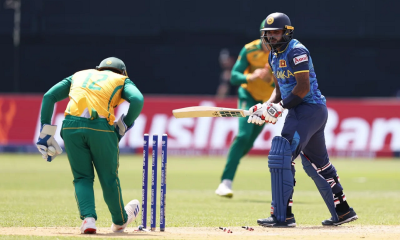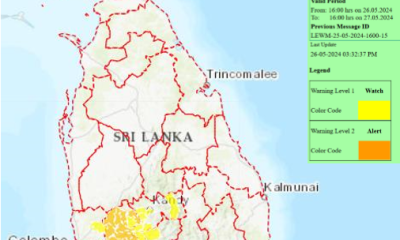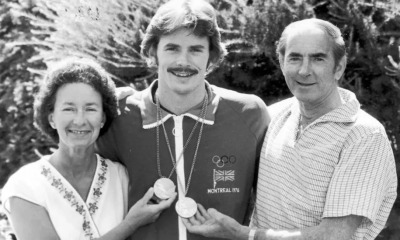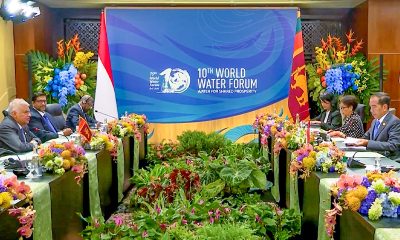Features
THOSE WERE THE DAYS

By AN OCTOGENARIAN
The Bridge on the River Kwai’ Though filmed in Sri Lanka was the award winning movie ‘The Bridge on the river Kwai,’ which was based on the building of a bridge 277 miles in length connecting Burma ( now known as Myanmar ) with Siam ( now known as Thailand ) during World War II by prisoners of war held by the Japanese. These POW were from Britain, Australia Holland , USA and around 200,000 conscripted civilians.
The highlight of the movie was the blowing up of the specially constructed bridge which spanned the Kelani Ganga in the picturesque and sleepy village of Kitulgala located at the foot of the Gingathena Pass. Directed by David Lean, it featured a star cast which included Sir Alec Guinness, William Holden, Jack Hawkins, Sessue Hayakawa and Anne Seans all of whom visited this island for the filming. Also included in this team was our own cameraman Willie Blake who was renowned for his filming of jungle life.
This movie will best be remembered for the “Colonel Bogey March,” which was whistled by the Allied prisoners of war as they marched on the orders of their Japanese captors. But mischievous schoolboys made the tune more spicy by introducing ribald and humorous lyrics about some of the war-time German Generals.
Emily and Vada Kaha Sudiya
June 20, 1955 will be always remembered as the day when there was a early morning total eclipse of the sun leaving Colombo in complete darkness. It was declared as a special holiday for schools. But there is another and no doubt a more popular reason for remembering this day. The baila describing the adventures of Emily who ‘daval kalay, ra vunu e davase’ consumed a decoction called ‘Vada kaha Sudiya’ in the hope of transforming her dark complexion into a fair and more attractive one. Poor Emily did not achieve her much desired objective but according to that baila all she did was to vomit !
Movies and Actors
Schoolboys who had only a limited amount of pocket money would pay 50 cents and sit in the gallery also called the ‘gallows’ which was located right in front of the cinema hall only a few yards from the screen to view their favorite movies. One of the most popular movies was the ‘Tarzan’ series featuring Johnny Weissmuller and Maureen O’Sullivan. Weissmuller’s fame was not so much as an actor but as a swimmer. Participating in the 1924 Paris Olympics and later in the 1928 Amsterdam Olympics he won a total of five gold medals.
This was also the time when the exploits of James Bond better known as the ’Saint’ co-authored by Leslie Charteris and Ian Fleming were featured in a series of novels which were avidly read by teenagers. Some of these novels were transformed into movies, beginning with “Doctor No” featuring Sean Connery in the lead role who almost overnight became one of the most popular Hollywood actors.
It was also the time when comics – a cartoon type of stories featuring heroes such as Captain Marvel, Superman, Batman, Spiderman and Tin Tin were surreptitiously read by schoolboys in preference to their school text books. Musically it was the time of Richard Clayderman , Billy Vaughn and his Orchestra, Frank Sinatra, Neil Diamond, Elton John , Nat King Cole , ABBA, The Beatles, The Platters and The Carpenters- sadly, this pair of siblings – Karen and Richard met with tragic ends. The former suffering from anorexia died of heart failure while the latter became a drug addict. Much later came the colorful and controversial Michael Jackson.
‘Blackboard Jungle’ was the movie in which Bill Hayley and his Comets sang ‘Rock Around the Clock’ as a result of which the younger generation put aside the traditional Quick Step and Waltzes which demanded nimble footwork and a close synchronization with one’s partner. Instead they adopted the gyrating type of dancing which anyone with even a basic sense of rhythm could do. On the opening night of this movie at the Savoy Cinema a group of youngsters got onto the stage and started performing the Rock and Roll. The Police had to be summoned to stop them and lead them outside the cinema hall.
Consumer Items
Some of the brands which have disappeared from our Super Market shelves in recent times were Lyles Golden Syrup, IXL Jam, Angiers Emulsion, Waterbury’s Compound , Andrews Liver Salts, Sunny South Butter, Globe Butter, Peek Freans Biscuits, Dutch Ball Cheese, Brylcream – a hair cream for men the press advertisement of which featured the popular English cricketer Dennis Compton, Cow & Gate milk powder, Ferradol, Farleys
Baby Rusks, Robinsons Patent Barley and Nabisco Biscuits. Mention must be made of two popular favorites amongst school boys. Bubble Gum and Bulto. The former was a type of chewing gum which with the flexibility of the tongue one was able to actually blow a bubble through the lips. Bulto was supposedly a misadventure which became a roaring success.
As to why it was given this name nobody seems to know. But the creator of this delicacy was an ‘Achchi’ who while making Kaludodol over-did the frying process and the expected Kaludodol became a sweet, hard, sticky mass. This was cut into pieces, wrapped in oil paper and sold. Overnight chewing Bulltoe became the latest craze. One could keep on chewing it for hours and most often it would get stuck between the upper and lower jaw teeth! Furthermore unlike chewing gum or bubble gum which had to be spat out after the chewing process was over. Bulltoe was meant to be chewed until it finally melted and what remained was swallowed.
Shopping, was a pleasant experience specially in Fort were there were the large department stores which were perhaps the precursor of the modern Super Markets – Whiteway Laidway more often referred to as Whitaways, Cargills, Millers, Broughams, and Colombo Apothecaries. There was also Caves which specialized in the sale of books. Opposite the Fort Railway Station was that landmark shop with the majestic name of ‘Fireworks Palace’. As the name indicates here could be found an abundance of fire-works. Amidst this vast array were Catherine Wheels, Squibs, Sky Rockets, Sparklers, Chinese Crackers which could be safely held in the hand as they burst with a tolerable bang.
For the more adventurous there was the ‘Ali Dong’ a cracker which went off like a bomb. At the far end along Dam Street in Pettah, was Mabel Stores, which stocked a whole heap of discarded military goods, such as boots, parachute silk, rolls of barbed wire, berets, kaki jackets, Woodbine cigarettes, and according to Walter Fernando –a leading hockey player in his time, Mabel Stores also stocked hockey sticks, and pads.
Pettah can also claim to have a fascinating collection of Dutch memorabilia such as street signs, steam rollers and printing presses, which are housed in the old Town Hall which was reconstructed to be a Dutch Museum with aid from institutions such as the Netherlands –Sri Lanka Foundation in the Hague and the Netherlands Alumni Association of Sri Lanka. Most unfortunately it is ‘Temporally Closed’ For how long is ‘Temporally’ is anybody’s guess.
Restaurants
Fountain Cafe which was owned by Ceylon Cold Stores, was essentially a family restaurant serving a vast array of tasty food amongst which were rolls, cutlets, patties , hot dogs. But their specialty was the sauce made, so it was claimed, according to a secret recipe. Little wonder that no other restaurant could match this delicacy . Alas! this iconic restaurant is no more.
Then there was Lion House located opposite the Majestic theater which was equally popular but for a different reason. It was open day and night and this was where groups or couples would stop their cars in the early hours of the morning after a Saturday night dance, to fortify themselves with egg hoppers and coffee served to the car door.
From Radio to TV
December 16, 1925 was a milestone in the history of broadcasting. It started with Colombo Radio, the first radio station in Asia and the second in the world. In October 1949 Colombo Radio was changed to Radio Ceylon, then in 1967 there was another name change – Ceylon Broadcasting Corporation., and finally when our island became a Republic in 1972 the present name was used – Sri Lanka Broadcasting Corporation.
With due respect to the many announcers whose voices gave life to radio broadcasting three names must be mentioned – Greg Roskowski, Vernon Corea and Bob Harvey. Of Sinhala announcers there is one name which stands out- Karunaratne Abeysekera
On April 15, 1979 Sri Lanka leapfrogged into the color TV era bypassing black and white TV thanks to two businessmen –Anil Wijewardena and Shan Wickremesinghe The new channel was called Independent Television Network (ITN) and commenced broadcasts from a small building in Pannipitiya. However on June 5 of that year ITN was taken over by the Government.
Features
The heart-friendly health minister

by Dr Gotabhya Ranasinghe
Senior Consultant Cardiologist
National Hospital Sri Lanka
When we sought a meeting with Hon Dr. Ramesh Pathirana, Minister of Health, he graciously cleared his busy schedule to accommodate us. Renowned for his attentive listening and deep understanding, Minister Pathirana is dedicated to advancing the health sector. His openness and transparency exemplify the qualities of an exemplary politician and minister.
Dr. Palitha Mahipala, the current Health Secretary, demonstrates both commendable enthusiasm and unwavering support. This combination of attributes makes him a highly compatible colleague for the esteemed Minister of Health.
Our discussion centered on a project that has been in the works for the past 30 years, one that no other minister had managed to advance.
Minister Pathirana, however, recognized the project’s significance and its potential to revolutionize care for heart patients.
The project involves the construction of a state-of-the-art facility at the premises of the National Hospital Colombo. The project’s location within the premises of the National Hospital underscores its importance and relevance to the healthcare infrastructure of the nation.
This facility will include a cardiology building and a tertiary care center, equipped with the latest technology to handle and treat all types of heart-related conditions and surgeries.
Securing funding was a major milestone for this initiative. Minister Pathirana successfully obtained approval for a $40 billion loan from the Asian Development Bank. With the funding in place, the foundation stone is scheduled to be laid in September this year, and construction will begin in January 2025.
This project guarantees a consistent and uninterrupted supply of stents and related medications for heart patients. As a result, patients will have timely access to essential medical supplies during their treatment and recovery. By securing these critical resources, the project aims to enhance patient outcomes, minimize treatment delays, and maintain the highest standards of cardiac care.
Upon its fruition, this monumental building will serve as a beacon of hope and healing, symbolizing the unwavering dedication to improving patient outcomes and fostering a healthier society.We anticipate a future marked by significant progress and positive outcomes in Sri Lanka’s cardiovascular treatment landscape within the foreseeable timeframe.
Features
A LOVING TRIBUTE TO JESUIT FR. ALOYSIUS PIERIS ON HIS 90th BIRTHDAY

by Fr. Emmanuel Fernando, OMI
Jesuit Fr. Aloysius Pieris (affectionately called Fr. Aloy) celebrated his 90th birthday on April 9, 2024 and I, as the editor of our Oblate Journal, THE MISSIONARY OBLATE had gone to press by that time. Immediately I decided to publish an article, appreciating the untiring selfless services he continues to offer for inter-Faith dialogue, the renewal of the Catholic Church, his concern for the poor and the suffering Sri Lankan masses and to me, the present writer.
It was in 1988, when I was appointed Director of the Oblate Scholastics at Ampitiya by the then Oblate Provincial Fr. Anselm Silva, that I came to know Fr. Aloy more closely. Knowing well his expertise in matters spiritual, theological, Indological and pastoral, and with the collaborative spirit of my companion-formators, our Oblate Scholastics were sent to Tulana, the Research and Encounter Centre, Kelaniya, of which he is the Founder-Director, for ‘exposure-programmes’ on matters spiritual, biblical, theological and pastoral. Some of these dimensions according to my view and that of my companion-formators, were not available at the National Seminary, Ampitiya.
Ever since that time, our Oblate formators/ accompaniers at the Oblate Scholasticate, Ampitiya , have continued to send our Oblate Scholastics to Tulana Centre for deepening their insights and convictions regarding matters needed to serve the people in today’s context. Fr. Aloy also had tried very enthusiastically with the Oblate team headed by Frs. Oswald Firth and Clement Waidyasekara to begin a Theologate, directed by the Religious Congregations in Sri Lanka, for the contextual formation/ accompaniment of their members. It should very well be a desired goal of the Leaders / Provincials of the Religious Congregations.
Besides being a formator/accompanier at the Oblate Scholasticate, I was entrusted also with the task of editing and publishing our Oblate journal, ‘The Missionary Oblate’. To maintain the quality of the journal I continue to depend on Fr. Aloy for his thought-provoking and stimulating articles on Biblical Spirituality, Biblical Theology and Ecclesiology. I am very grateful to him for his generous assistance. Of late, his writings on renewal of the Church, initiated by Pope St. John XX111 and continued by Pope Francis through the Synodal path, published in our Oblate journal, enable our readers to focus their attention also on the needed renewal in the Catholic Church in Sri Lanka. Fr. Aloy appreciated very much the Synodal path adopted by the Jesuit Pope Francis for the renewal of the Church, rooted very much on prayerful discernment. In my Religious and presbyteral life, Fr.Aloy continues to be my spiritual animator / guide and ongoing formator / acccompanier.
Fr. Aloysius Pieris, BA Hons (Lond), LPh (SHC, India), STL (PFT, Naples), PhD (SLU/VC), ThD (Tilburg), D.Ltt (KU), has been one of the eminent Asian theologians well recognized internationally and one who has lectured and held visiting chairs in many universities both in the West and in the East. Many members of Religious Congregations from Asian countries have benefited from his lectures and guidance in the East Asian Pastoral Institute (EAPI) in Manila, Philippines. He had been a Theologian consulted by the Federation of Asian Bishops’ Conferences for many years. During his professorship at the Gregorian University in Rome, he was called to be a member of a special group of advisers on other religions consulted by Pope Paul VI.
Fr. Aloy is the author of more than 30 books and well over 500 Research Papers. Some of his books and articles have been translated and published in several countries. Among those books, one can find the following: 1) The Genesis of an Asian Theology of Liberation (An Autobiographical Excursus on the Art of Theologising in Asia, 2) An Asian Theology of Liberation, 3) Providential Timeliness of Vatican 11 (a long-overdue halt to a scandalous millennium, 4) Give Vatican 11 a chance, 5) Leadership in the Church, 6) Relishing our faith in working for justice (Themes for study and discussion), 7) A Message meant mainly, not exclusively for Jesuits (Background information necessary for helping Francis renew the Church), 8) Lent in Lanka (Reflections and Resolutions, 9) Love meets wisdom (A Christian Experience of Buddhism, 10) Fire and Water 11) God’s Reign for God’s poor, 12) Our Unhiddden Agenda (How we Jesuits work, pray and form our men). He is also the Editor of two journals, Vagdevi, Journal of Religious Reflection and Dialogue, New Series.
Fr. Aloy has a BA in Pali and Sanskrit from the University of London and a Ph.D in Buddhist Philosophy from the University of Sri Lankan, Vidyodaya Campus. On Nov. 23, 2019, he was awarded the prestigious honorary Doctorate of Literature (D.Litt) by the Chancellor of the University of Kelaniya, the Most Venerable Welamitiyawe Dharmakirthi Sri Kusala Dhamma Thera.
Fr. Aloy continues to be a promoter of Gospel values and virtues. Justice as a constitutive dimension of love and social concern for the downtrodden masses are very much noted in his life and work. He had very much appreciated the commitment of the late Fr. Joseph (Joe) Fernando, the National Director of the Social and Economic Centre (SEDEC) for the poor.
In Sri Lanka, a few religious Congregations – the Good Shepherd Sisters, the Christian Brothers, the Marist Brothers and the Oblates – have invited him to animate their members especially during their Provincial Congresses, Chapters and International Conferences. The mainline Christian Churches also have sought his advice and followed his seminars. I, for one, regret very much, that the Sri Lankan authorities of the Catholic Church –today’s Hierarchy—- have not sought Fr.
Aloy’s expertise for the renewal of the Catholic Church in Sri Lanka and thus have not benefited from the immense store of wisdom and insight that he can offer to our local Church while the Sri Lankan bishops who governed the Catholic church in the immediate aftermath of the Second Vatican Council (Edmund Fernando OMI, Anthony de Saram, Leo Nanayakkara OSB, Frank Marcus Fernando, Paul Perera,) visited him and consulted him on many matters. Among the Tamil Bishops, Bishop Rayappu Joseph was keeping close contact with him and Bishop J. Deogupillai hosted him and his team visiting him after the horrible Black July massacre of Tamils.
Features
A fairy tale, success or debacle

Sri Lanka-Singapore Free Trade Agreement
By Gomi Senadhira
senadhiragomi@gmail.com
“You might tell fairy tales, but the progress of a country cannot be achieved through such narratives. A country cannot be developed by making false promises. The country moved backward because of the electoral promises made by political parties throughout time. We have witnessed that the ultimate result of this is the country becoming bankrupt. Unfortunately, many segments of the population have not come to realize this yet.” – President Ranil Wickremesinghe, 2024 Budget speech
Any Sri Lankan would agree with the above words of President Wickremesinghe on the false promises our politicians and officials make and the fairy tales they narrate which bankrupted this country. So, to understand this, let’s look at one such fairy tale with lots of false promises; Ranil Wickremesinghe’s greatest achievement in the area of international trade and investment promotion during the Yahapalana period, Sri Lanka-Singapore Free Trade Agreement (SLSFTA).
It is appropriate and timely to do it now as Finance Minister Wickremesinghe has just presented to parliament a bill on the National Policy on Economic Transformation which includes the establishment of an Office for International Trade and the Sri Lanka Institute of Economics and International Trade.
Was SLSFTA a “Cleverly negotiated Free Trade Agreement” as stated by the (former) Minister of Development Strategies and International Trade Malik Samarawickrama during the Parliamentary Debate on the SLSFTA in July 2018, or a colossal blunder covered up with lies, false promises, and fairy tales? After SLSFTA was signed there were a number of fairy tales published on this agreement by the Ministry of Development Strategies and International, Institute of Policy Studies, and others.
However, for this article, I would like to limit my comments to the speech by Minister Samarawickrama during the Parliamentary Debate, and the two most important areas in the agreement which were covered up with lies, fairy tales, and false promises, namely: revenue loss for Sri Lanka and Investment from Singapore. On the other important area, “Waste products dumping” I do not want to comment here as I have written extensively on the issue.
1. The revenue loss
During the Parliamentary Debate in July 2018, Minister Samarawickrama stated “…. let me reiterate that this FTA with Singapore has been very cleverly negotiated by us…. The liberalisation programme under this FTA has been carefully designed to have the least impact on domestic industry and revenue collection. We have included all revenue sensitive items in the negative list of items which will not be subject to removal of tariff. Therefore, 97.8% revenue from Customs duty is protected. Our tariff liberalisation will take place over a period of 12-15 years! In fact, the revenue earned through tariffs on goods imported from Singapore last year was Rs. 35 billion.
The revenue loss for over the next 15 years due to the FTA is only Rs. 733 million– which when annualised, on average, is just Rs. 51 million. That is just 0.14% per year! So anyone who claims the Singapore FTA causes revenue loss to the Government cannot do basic arithmetic! Mr. Speaker, in conclusion, I call on my fellow members of this House – don’t mislead the public with baseless criticism that is not grounded in facts. Don’t look at petty politics and use these issues for your own political survival.”
I was surprised to read the minister’s speech because an article published in January 2018 in “The Straits Times“, based on information released by the Singaporean Negotiators stated, “…. With the FTA, tariff savings for Singapore exports are estimated to hit $10 million annually“.
As the annual tariff savings (that is the revenue loss for Sri Lanka) calculated by the Singaporean Negotiators, Singaporean $ 10 million (Sri Lankan rupees 1,200 million in 2018) was way above the rupees’ 733 million revenue loss for 15 years estimated by the Sri Lankan negotiators, it was clear to any observer that one of the parties to the agreement had not done the basic arithmetic!
Six years later, according to a report published by “The Morning” newspaper, speaking at the Committee on Public Finance (COPF) on 7th May 2024, Mr Samarawickrama’s chief trade negotiator K.J. Weerasinghehad had admitted “…. that forecasted revenue loss for the Government of Sri Lanka through the Singapore FTA is Rs. 450 million in 2023 and Rs. 1.3 billion in 2024.”
If these numbers are correct, as tariff liberalisation under the SLSFTA has just started, we will pass Rs 2 billion very soon. Then, the question is how Sri Lanka’s trade negotiators made such a colossal blunder. Didn’t they do their basic arithmetic? If they didn’t know how to do basic arithmetic they should have at least done their basic readings. For example, the headline of the article published in The Straits Times in January 2018 was “Singapore, Sri Lanka sign FTA, annual savings of $10m expected”.
Anyway, as Sri Lanka’s chief negotiator reiterated at the COPF meeting that “…. since 99% of the tariffs in Singapore have zero rates of duty, Sri Lanka has agreed on 80% tariff liberalisation over a period of 15 years while expecting Singapore investments to address the imbalance in trade,” let’s turn towards investment.
Investment from Singapore
In July 2018, speaking during the Parliamentary Debate on the FTA this is what Minister Malik Samarawickrama stated on investment from Singapore, “Already, thanks to this FTA, in just the past two-and-a-half months since the agreement came into effect we have received a proposal from Singapore for investment amounting to $ 14.8 billion in an oil refinery for export of petroleum products. In addition, we have proposals for a steel manufacturing plant for exports ($ 1 billion investment), flour milling plant ($ 50 million), sugar refinery ($ 200 million). This adds up to more than $ 16.05 billion in the pipeline on these projects alone.
And all of these projects will create thousands of more jobs for our people. In principle approval has already been granted by the BOI and the investors are awaiting the release of land the environmental approvals to commence the project.
I request the Opposition and those with vested interests to change their narrow-minded thinking and join us to develop our country. We must always look at what is best for the whole community, not just the few who may oppose. We owe it to our people to courageously take decisions that will change their lives for the better.”
According to the media report I quoted earlier, speaking at the Committee on Public Finance (COPF) Chief Negotiator Weerasinghe has admitted that Sri Lanka was not happy with overall Singapore investments that have come in the past few years in return for the trade liberalisation under the Singapore-Sri Lanka Free Trade Agreement. He has added that between 2021 and 2023 the total investment from Singapore had been around $162 million!
What happened to those projects worth $16 billion negotiated, thanks to the SLSFTA, in just the two-and-a-half months after the agreement came into effect and approved by the BOI? I do not know about the steel manufacturing plant for exports ($ 1 billion investment), flour milling plant ($ 50 million) and sugar refinery ($ 200 million).
However, story of the multibillion-dollar investment in the Petroleum Refinery unfolded in a manner that would qualify it as the best fairy tale with false promises presented by our politicians and the officials, prior to 2019 elections.
Though many Sri Lankans got to know, through the media which repeatedly highlighted a plethora of issues surrounding the project and the questionable credentials of the Singaporean investor, the construction work on the Mirrijiwela Oil Refinery along with the cement factory began on the24th of March 2019 with a bang and Minister Ranil Wickremesinghe and his ministers along with the foreign and local dignitaries laid the foundation stones.
That was few months before the 2019 Presidential elections. Inaugurating the construction work Prime Minister Ranil Wickremesinghe said the projects will create thousands of job opportunities in the area and surrounding districts.
The oil refinery, which was to be built over 200 acres of land, with the capacity to refine 200,000 barrels of crude oil per day, was to generate US$7 billion of exports and create 1,500 direct and 3,000 indirect jobs. The construction of the refinery was to be completed in 44 months. Four years later, in August 2023 the Cabinet of Ministers approved the proposal presented by President Ranil Wickremesinghe to cancel the agreement with the investors of the refinery as the project has not been implemented! Can they explain to the country how much money was wasted to produce that fairy tale?
It is obvious that the President, ministers, and officials had made huge blunders and had deliberately misled the public and the parliament on the revenue loss and potential investment from SLSFTA with fairy tales and false promises.
As the president himself said, a country cannot be developed by making false promises or with fairy tales and these false promises and fairy tales had bankrupted the country. “Unfortunately, many segments of the population have not come to realize this yet”.
(The writer, a specialist and an activist on trade and development issues . )
























